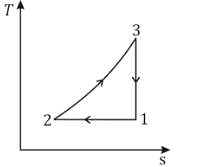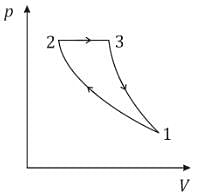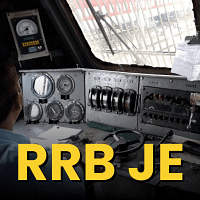Railways Exam > Railways Questions > An ideal air standard cycle is shown in the ...
Start Learning for Free
An ideal air standard cycle is shown in the given temperature-entropy diagram

The same cycle, when represented on the pressure-volume coordinates, takes the form.
- a)

- b)

- c)

- d)

Correct answer is option 'A'. Can you explain this answer?
| FREE This question is part of | Download PDF Attempt this Test |
Verified Answer
An ideal air standard cycle is shown in the given temperature-entropy...
In T - S diagram
Process 1 - 2 → Isothermal process
Process 3 -1 → reversible adiabatic process
Thus, on the P-V diagram, the slope of the reversible adiabatic process
(3-1) is more than the slope of the isothermal process (1 - 2).
Process 2 - 3 → isobaric process line

|
Explore Courses for Railways exam
|

|
An ideal air standard cycle is shown in the given temperature-entropy diagramThe same cycle, when represented on the pressure-volume coordinates, takes the form.a)b)c)d)Correct answer is option 'A'. Can you explain this answer?
Question Description
An ideal air standard cycle is shown in the given temperature-entropy diagramThe same cycle, when represented on the pressure-volume coordinates, takes the form.a)b)c)d)Correct answer is option 'A'. Can you explain this answer? for Railways 2024 is part of Railways preparation. The Question and answers have been prepared according to the Railways exam syllabus. Information about An ideal air standard cycle is shown in the given temperature-entropy diagramThe same cycle, when represented on the pressure-volume coordinates, takes the form.a)b)c)d)Correct answer is option 'A'. Can you explain this answer? covers all topics & solutions for Railways 2024 Exam. Find important definitions, questions, meanings, examples, exercises and tests below for An ideal air standard cycle is shown in the given temperature-entropy diagramThe same cycle, when represented on the pressure-volume coordinates, takes the form.a)b)c)d)Correct answer is option 'A'. Can you explain this answer?.
An ideal air standard cycle is shown in the given temperature-entropy diagramThe same cycle, when represented on the pressure-volume coordinates, takes the form.a)b)c)d)Correct answer is option 'A'. Can you explain this answer? for Railways 2024 is part of Railways preparation. The Question and answers have been prepared according to the Railways exam syllabus. Information about An ideal air standard cycle is shown in the given temperature-entropy diagramThe same cycle, when represented on the pressure-volume coordinates, takes the form.a)b)c)d)Correct answer is option 'A'. Can you explain this answer? covers all topics & solutions for Railways 2024 Exam. Find important definitions, questions, meanings, examples, exercises and tests below for An ideal air standard cycle is shown in the given temperature-entropy diagramThe same cycle, when represented on the pressure-volume coordinates, takes the form.a)b)c)d)Correct answer is option 'A'. Can you explain this answer?.
Solutions for An ideal air standard cycle is shown in the given temperature-entropy diagramThe same cycle, when represented on the pressure-volume coordinates, takes the form.a)b)c)d)Correct answer is option 'A'. Can you explain this answer? in English & in Hindi are available as part of our courses for Railways.
Download more important topics, notes, lectures and mock test series for Railways Exam by signing up for free.
Here you can find the meaning of An ideal air standard cycle is shown in the given temperature-entropy diagramThe same cycle, when represented on the pressure-volume coordinates, takes the form.a)b)c)d)Correct answer is option 'A'. Can you explain this answer? defined & explained in the simplest way possible. Besides giving the explanation of
An ideal air standard cycle is shown in the given temperature-entropy diagramThe same cycle, when represented on the pressure-volume coordinates, takes the form.a)b)c)d)Correct answer is option 'A'. Can you explain this answer?, a detailed solution for An ideal air standard cycle is shown in the given temperature-entropy diagramThe same cycle, when represented on the pressure-volume coordinates, takes the form.a)b)c)d)Correct answer is option 'A'. Can you explain this answer? has been provided alongside types of An ideal air standard cycle is shown in the given temperature-entropy diagramThe same cycle, when represented on the pressure-volume coordinates, takes the form.a)b)c)d)Correct answer is option 'A'. Can you explain this answer? theory, EduRev gives you an
ample number of questions to practice An ideal air standard cycle is shown in the given temperature-entropy diagramThe same cycle, when represented on the pressure-volume coordinates, takes the form.a)b)c)d)Correct answer is option 'A'. Can you explain this answer? tests, examples and also practice Railways tests.

|
Explore Courses for Railways exam
|

|
Suggested Free Tests
Signup for Free!
Signup to see your scores go up within 7 days! Learn & Practice with 1000+ FREE Notes, Videos & Tests.





















